University Healthcare Research: Belmont Report Decision Memo
VerifiedAdded on 2022/08/12
|7
|1521
|24
Report
AI Summary
This memo addresses the critical issue of healthcare-associated infections (HAIs) and proposes the application of the Belmont Report's ethical principles to mitigate their occurrence. It begins by outlining the problem of HAIs, citing statistics on their prevalence and associated mortality rates. The analysis emphasizes the importance of adhering to ethical principles, particularly non-maleficence, and argues that the Belmont Report—encompassing respect for persons, beneficence, and justice—provides a framework for improving patient care and reducing infections. The memo recommends hand hygiene as a practical, cost-effective intervention aligned with these principles. It highlights the importance of treating patients as autonomous agents, prioritizing their health, and ensuring equitable treatment to reduce the risk of HAIs. The memo concludes by advocating for the adoption of these ethical guidelines to safeguard both patients and researchers.
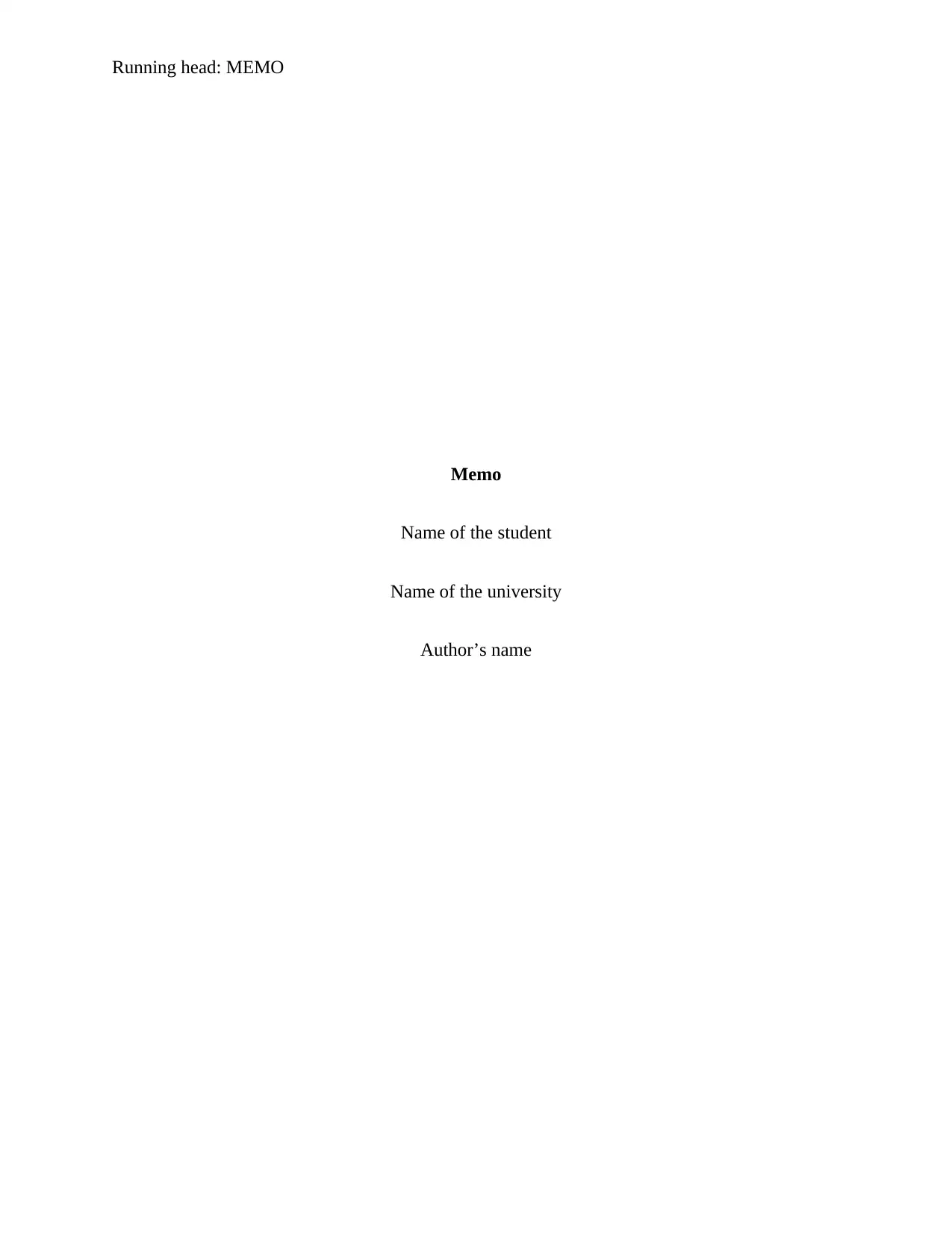
Running head: MEMO
Memo
Name of the student
Name of the university
Author’s name
Memo
Name of the student
Name of the university
Author’s name
Paraphrase This Document
Need a fresh take? Get an instant paraphrase of this document with our AI Paraphraser
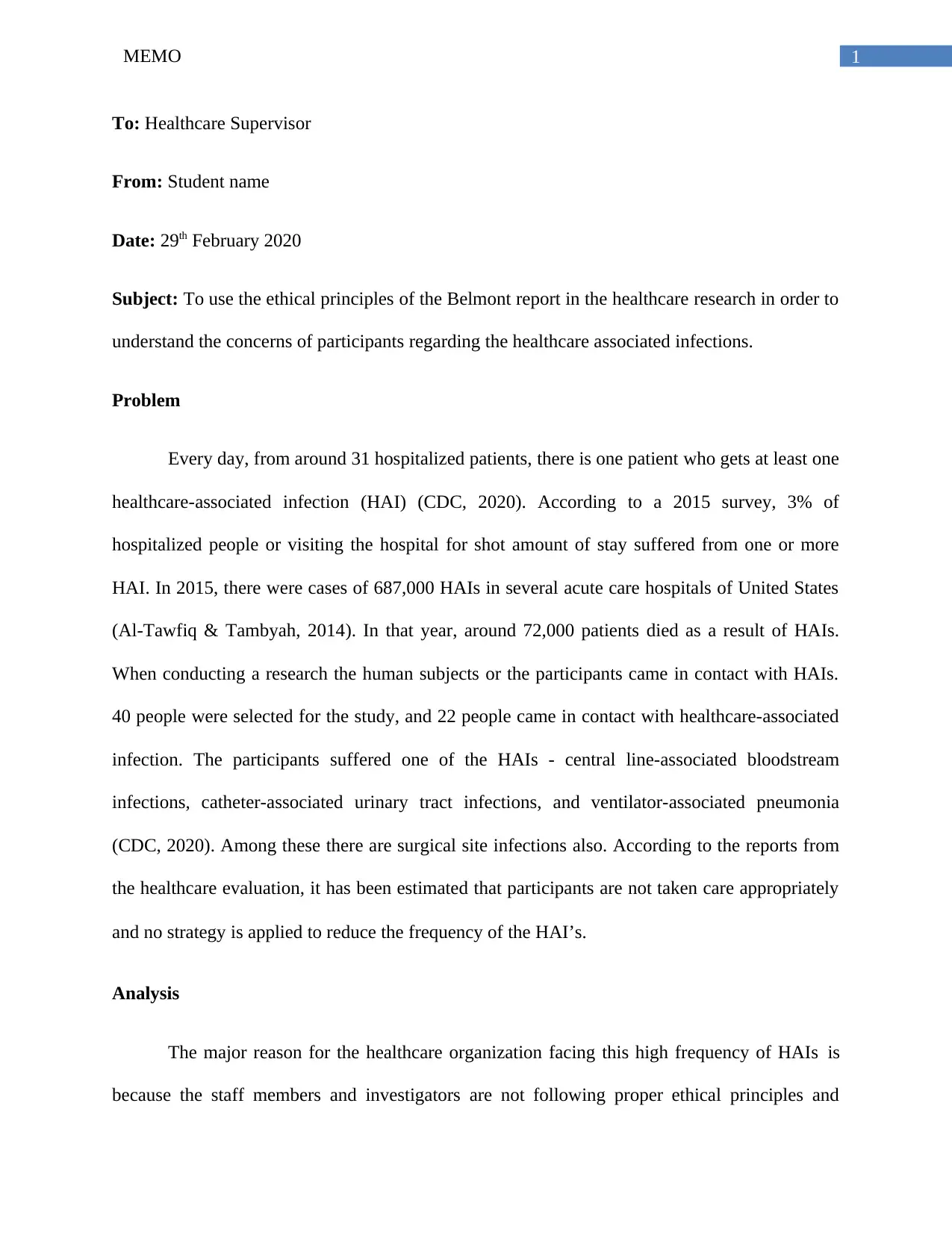
1MEMO
To: Healthcare Supervisor
From: Student name
Date: 29th February 2020
Subject: To use the ethical principles of the Belmont report in the healthcare research in order to
understand the concerns of participants regarding the healthcare associated infections.
Problem
Every day, from around 31 hospitalized patients, there is one patient who gets at least one
healthcare-associated infection (HAI) (CDC, 2020). According to a 2015 survey, 3% of
hospitalized people or visiting the hospital for shot amount of stay suffered from one or more
HAI. In 2015, there were cases of 687,000 HAIs in several acute care hospitals of United States
(Al-Tawfiq & Tambyah, 2014). In that year, around 72,000 patients died as a result of HAIs.
When conducting a research the human subjects or the participants came in contact with HAIs.
40 people were selected for the study, and 22 people came in contact with healthcare-associated
infection. The participants suffered one of the HAIs - central line-associated bloodstream
infections, catheter-associated urinary tract infections, and ventilator-associated pneumonia
(CDC, 2020). Among these there are surgical site infections also. According to the reports from
the healthcare evaluation, it has been estimated that participants are not taken care appropriately
and no strategy is applied to reduce the frequency of the HAI’s.
Analysis
The major reason for the healthcare organization facing this high frequency of HAIs is
because the staff members and investigators are not following proper ethical principles and
To: Healthcare Supervisor
From: Student name
Date: 29th February 2020
Subject: To use the ethical principles of the Belmont report in the healthcare research in order to
understand the concerns of participants regarding the healthcare associated infections.
Problem
Every day, from around 31 hospitalized patients, there is one patient who gets at least one
healthcare-associated infection (HAI) (CDC, 2020). According to a 2015 survey, 3% of
hospitalized people or visiting the hospital for shot amount of stay suffered from one or more
HAI. In 2015, there were cases of 687,000 HAIs in several acute care hospitals of United States
(Al-Tawfiq & Tambyah, 2014). In that year, around 72,000 patients died as a result of HAIs.
When conducting a research the human subjects or the participants came in contact with HAIs.
40 people were selected for the study, and 22 people came in contact with healthcare-associated
infection. The participants suffered one of the HAIs - central line-associated bloodstream
infections, catheter-associated urinary tract infections, and ventilator-associated pneumonia
(CDC, 2020). Among these there are surgical site infections also. According to the reports from
the healthcare evaluation, it has been estimated that participants are not taken care appropriately
and no strategy is applied to reduce the frequency of the HAI’s.
Analysis
The major reason for the healthcare organization facing this high frequency of HAIs is
because the staff members and investigators are not following proper ethical principles and
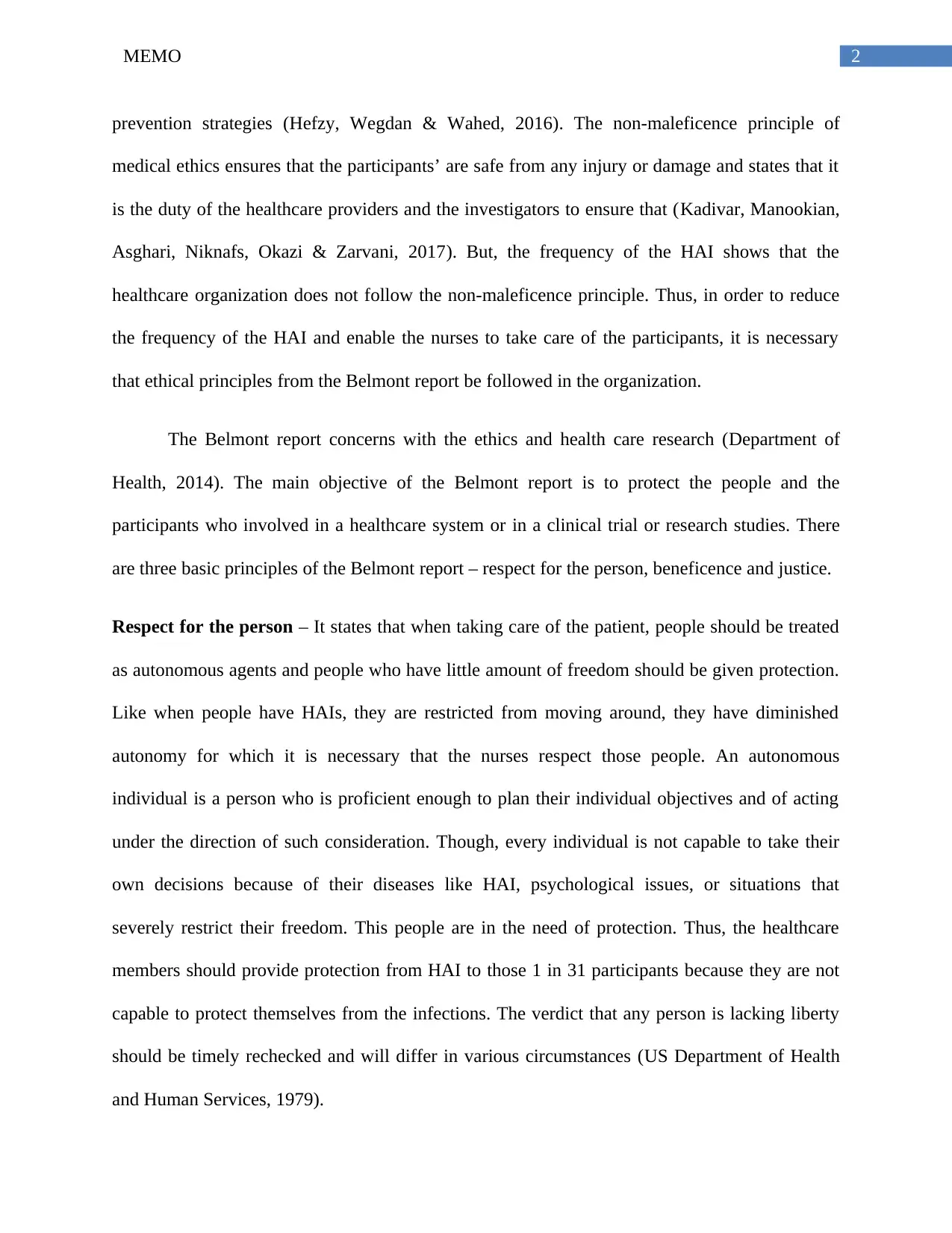
2MEMO
prevention strategies (Hefzy, Wegdan & Wahed, 2016). The non-maleficence principle of
medical ethics ensures that the participants’ are safe from any injury or damage and states that it
is the duty of the healthcare providers and the investigators to ensure that (Kadivar, Manookian,
Asghari, Niknafs, Okazi & Zarvani, 2017). But, the frequency of the HAI shows that the
healthcare organization does not follow the non-maleficence principle. Thus, in order to reduce
the frequency of the HAI and enable the nurses to take care of the participants, it is necessary
that ethical principles from the Belmont report be followed in the organization.
The Belmont report concerns with the ethics and health care research (Department of
Health, 2014). The main objective of the Belmont report is to protect the people and the
participants who involved in a healthcare system or in a clinical trial or research studies. There
are three basic principles of the Belmont report – respect for the person, beneficence and justice.
Respect for the person – It states that when taking care of the patient, people should be treated
as autonomous agents and people who have little amount of freedom should be given protection.
Like when people have HAIs, they are restricted from moving around, they have diminished
autonomy for which it is necessary that the nurses respect those people. An autonomous
individual is a person who is proficient enough to plan their individual objectives and of acting
under the direction of such consideration. Though, every individual is not capable to take their
own decisions because of their diseases like HAI, psychological issues, or situations that
severely restrict their freedom. This people are in the need of protection. Thus, the healthcare
members should provide protection from HAI to those 1 in 31 participants because they are not
capable to protect themselves from the infections. The verdict that any person is lacking liberty
should be timely rechecked and will differ in various circumstances (US Department of Health
and Human Services, 1979).
prevention strategies (Hefzy, Wegdan & Wahed, 2016). The non-maleficence principle of
medical ethics ensures that the participants’ are safe from any injury or damage and states that it
is the duty of the healthcare providers and the investigators to ensure that (Kadivar, Manookian,
Asghari, Niknafs, Okazi & Zarvani, 2017). But, the frequency of the HAI shows that the
healthcare organization does not follow the non-maleficence principle. Thus, in order to reduce
the frequency of the HAI and enable the nurses to take care of the participants, it is necessary
that ethical principles from the Belmont report be followed in the organization.
The Belmont report concerns with the ethics and health care research (Department of
Health, 2014). The main objective of the Belmont report is to protect the people and the
participants who involved in a healthcare system or in a clinical trial or research studies. There
are three basic principles of the Belmont report – respect for the person, beneficence and justice.
Respect for the person – It states that when taking care of the patient, people should be treated
as autonomous agents and people who have little amount of freedom should be given protection.
Like when people have HAIs, they are restricted from moving around, they have diminished
autonomy for which it is necessary that the nurses respect those people. An autonomous
individual is a person who is proficient enough to plan their individual objectives and of acting
under the direction of such consideration. Though, every individual is not capable to take their
own decisions because of their diseases like HAI, psychological issues, or situations that
severely restrict their freedom. This people are in the need of protection. Thus, the healthcare
members should provide protection from HAI to those 1 in 31 participants because they are not
capable to protect themselves from the infections. The verdict that any person is lacking liberty
should be timely rechecked and will differ in various circumstances (US Department of Health
and Human Services, 1979).
⊘ This is a preview!⊘
Do you want full access?
Subscribe today to unlock all pages.

Trusted by 1+ million students worldwide
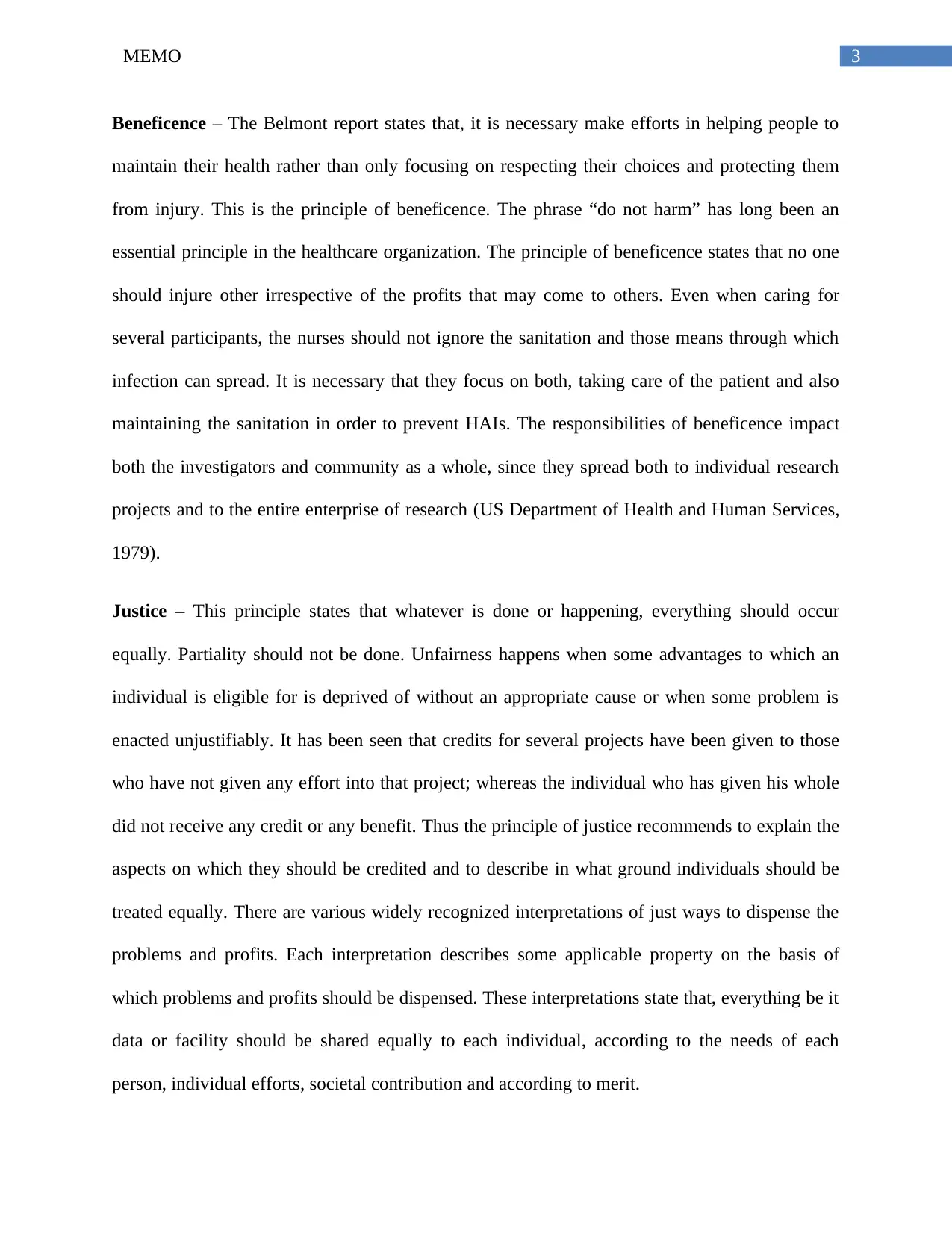
3MEMO
Beneficence – The Belmont report states that, it is necessary make efforts in helping people to
maintain their health rather than only focusing on respecting their choices and protecting them
from injury. This is the principle of beneficence. The phrase “do not harm” has long been an
essential principle in the healthcare organization. The principle of beneficence states that no one
should injure other irrespective of the profits that may come to others. Even when caring for
several participants, the nurses should not ignore the sanitation and those means through which
infection can spread. It is necessary that they focus on both, taking care of the patient and also
maintaining the sanitation in order to prevent HAIs. The responsibilities of beneficence impact
both the investigators and community as a whole, since they spread both to individual research
projects and to the entire enterprise of research (US Department of Health and Human Services,
1979).
Justice – This principle states that whatever is done or happening, everything should occur
equally. Partiality should not be done. Unfairness happens when some advantages to which an
individual is eligible for is deprived of without an appropriate cause or when some problem is
enacted unjustifiably. It has been seen that credits for several projects have been given to those
who have not given any effort into that project; whereas the individual who has given his whole
did not receive any credit or any benefit. Thus the principle of justice recommends to explain the
aspects on which they should be credited and to describe in what ground individuals should be
treated equally. There are various widely recognized interpretations of just ways to dispense the
problems and profits. Each interpretation describes some applicable property on the basis of
which problems and profits should be dispensed. These interpretations state that, everything be it
data or facility should be shared equally to each individual, according to the needs of each
person, individual efforts, societal contribution and according to merit.
Beneficence – The Belmont report states that, it is necessary make efforts in helping people to
maintain their health rather than only focusing on respecting their choices and protecting them
from injury. This is the principle of beneficence. The phrase “do not harm” has long been an
essential principle in the healthcare organization. The principle of beneficence states that no one
should injure other irrespective of the profits that may come to others. Even when caring for
several participants, the nurses should not ignore the sanitation and those means through which
infection can spread. It is necessary that they focus on both, taking care of the patient and also
maintaining the sanitation in order to prevent HAIs. The responsibilities of beneficence impact
both the investigators and community as a whole, since they spread both to individual research
projects and to the entire enterprise of research (US Department of Health and Human Services,
1979).
Justice – This principle states that whatever is done or happening, everything should occur
equally. Partiality should not be done. Unfairness happens when some advantages to which an
individual is eligible for is deprived of without an appropriate cause or when some problem is
enacted unjustifiably. It has been seen that credits for several projects have been given to those
who have not given any effort into that project; whereas the individual who has given his whole
did not receive any credit or any benefit. Thus the principle of justice recommends to explain the
aspects on which they should be credited and to describe in what ground individuals should be
treated equally. There are various widely recognized interpretations of just ways to dispense the
problems and profits. Each interpretation describes some applicable property on the basis of
which problems and profits should be dispensed. These interpretations state that, everything be it
data or facility should be shared equally to each individual, according to the needs of each
person, individual efforts, societal contribution and according to merit.
Paraphrase This Document
Need a fresh take? Get an instant paraphrase of this document with our AI Paraphraser
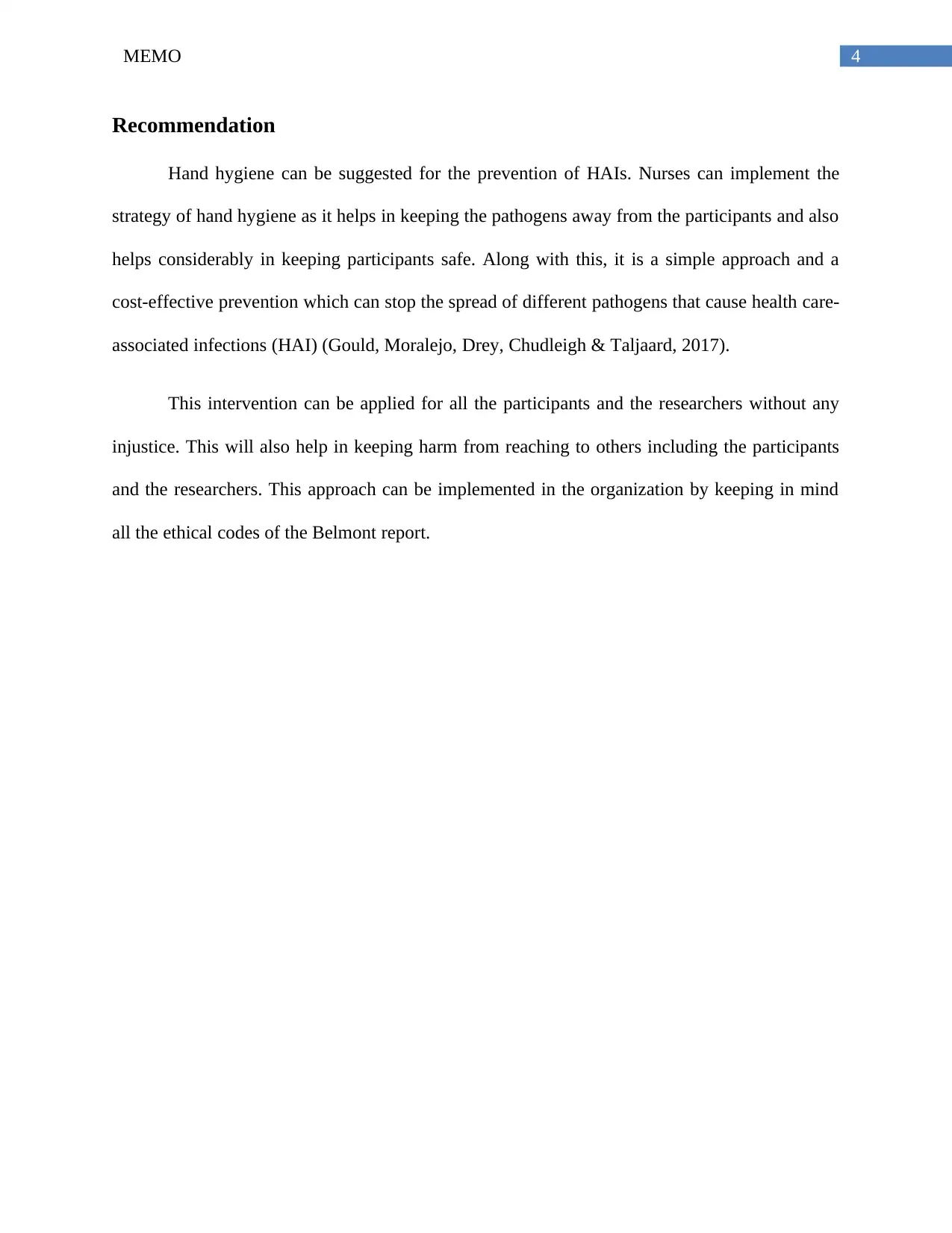
4MEMO
Recommendation
Hand hygiene can be suggested for the prevention of HAIs. Nurses can implement the
strategy of hand hygiene as it helps in keeping the pathogens away from the participants and also
helps considerably in keeping participants safe. Along with this, it is a simple approach and a
cost-effective prevention which can stop the spread of different pathogens that cause health care-
associated infections (HAI) (Gould, Moralejo, Drey, Chudleigh & Taljaard, 2017).
This intervention can be applied for all the participants and the researchers without any
injustice. This will also help in keeping harm from reaching to others including the participants
and the researchers. This approach can be implemented in the organization by keeping in mind
all the ethical codes of the Belmont report.
Recommendation
Hand hygiene can be suggested for the prevention of HAIs. Nurses can implement the
strategy of hand hygiene as it helps in keeping the pathogens away from the participants and also
helps considerably in keeping participants safe. Along with this, it is a simple approach and a
cost-effective prevention which can stop the spread of different pathogens that cause health care-
associated infections (HAI) (Gould, Moralejo, Drey, Chudleigh & Taljaard, 2017).
This intervention can be applied for all the participants and the researchers without any
injustice. This will also help in keeping harm from reaching to others including the participants
and the researchers. This approach can be implemented in the organization by keeping in mind
all the ethical codes of the Belmont report.
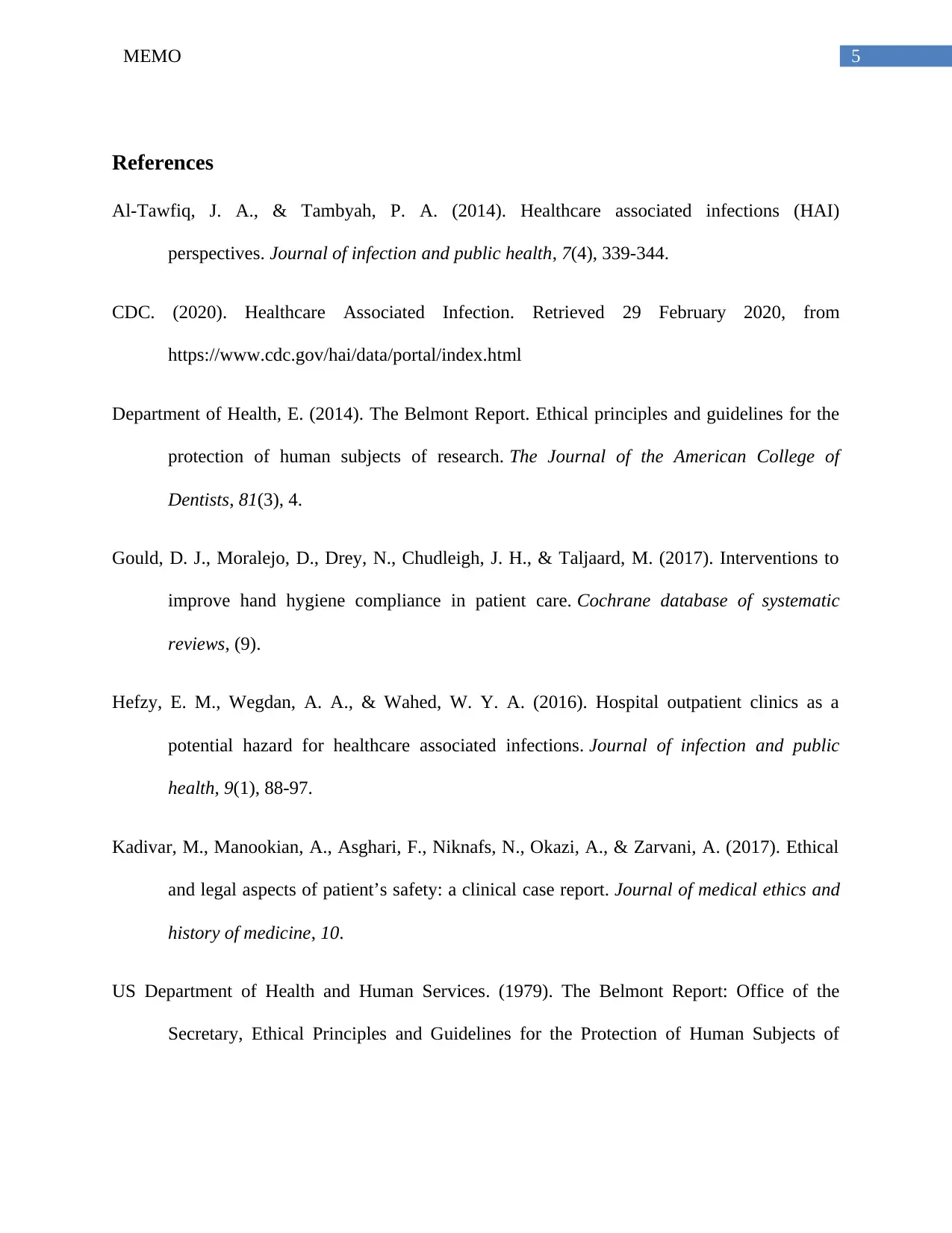
5MEMO
References
Al-Tawfiq, J. A., & Tambyah, P. A. (2014). Healthcare associated infections (HAI)
perspectives. Journal of infection and public health, 7(4), 339-344.
CDC. (2020). Healthcare Associated Infection. Retrieved 29 February 2020, from
https://www.cdc.gov/hai/data/portal/index.html
Department of Health, E. (2014). The Belmont Report. Ethical principles and guidelines for the
protection of human subjects of research. The Journal of the American College of
Dentists, 81(3), 4.
Gould, D. J., Moralejo, D., Drey, N., Chudleigh, J. H., & Taljaard, M. (2017). Interventions to
improve hand hygiene compliance in patient care. Cochrane database of systematic
reviews, (9).
Hefzy, E. M., Wegdan, A. A., & Wahed, W. Y. A. (2016). Hospital outpatient clinics as a
potential hazard for healthcare associated infections. Journal of infection and public
health, 9(1), 88-97.
Kadivar, M., Manookian, A., Asghari, F., Niknafs, N., Okazi, A., & Zarvani, A. (2017). Ethical
and legal aspects of patient’s safety: a clinical case report. Journal of medical ethics and
history of medicine, 10.
US Department of Health and Human Services. (1979). The Belmont Report: Office of the
Secretary, Ethical Principles and Guidelines for the Protection of Human Subjects of
References
Al-Tawfiq, J. A., & Tambyah, P. A. (2014). Healthcare associated infections (HAI)
perspectives. Journal of infection and public health, 7(4), 339-344.
CDC. (2020). Healthcare Associated Infection. Retrieved 29 February 2020, from
https://www.cdc.gov/hai/data/portal/index.html
Department of Health, E. (2014). The Belmont Report. Ethical principles and guidelines for the
protection of human subjects of research. The Journal of the American College of
Dentists, 81(3), 4.
Gould, D. J., Moralejo, D., Drey, N., Chudleigh, J. H., & Taljaard, M. (2017). Interventions to
improve hand hygiene compliance in patient care. Cochrane database of systematic
reviews, (9).
Hefzy, E. M., Wegdan, A. A., & Wahed, W. Y. A. (2016). Hospital outpatient clinics as a
potential hazard for healthcare associated infections. Journal of infection and public
health, 9(1), 88-97.
Kadivar, M., Manookian, A., Asghari, F., Niknafs, N., Okazi, A., & Zarvani, A. (2017). Ethical
and legal aspects of patient’s safety: a clinical case report. Journal of medical ethics and
history of medicine, 10.
US Department of Health and Human Services. (1979). The Belmont Report: Office of the
Secretary, Ethical Principles and Guidelines for the Protection of Human Subjects of
⊘ This is a preview!⊘
Do you want full access?
Subscribe today to unlock all pages.

Trusted by 1+ million students worldwide
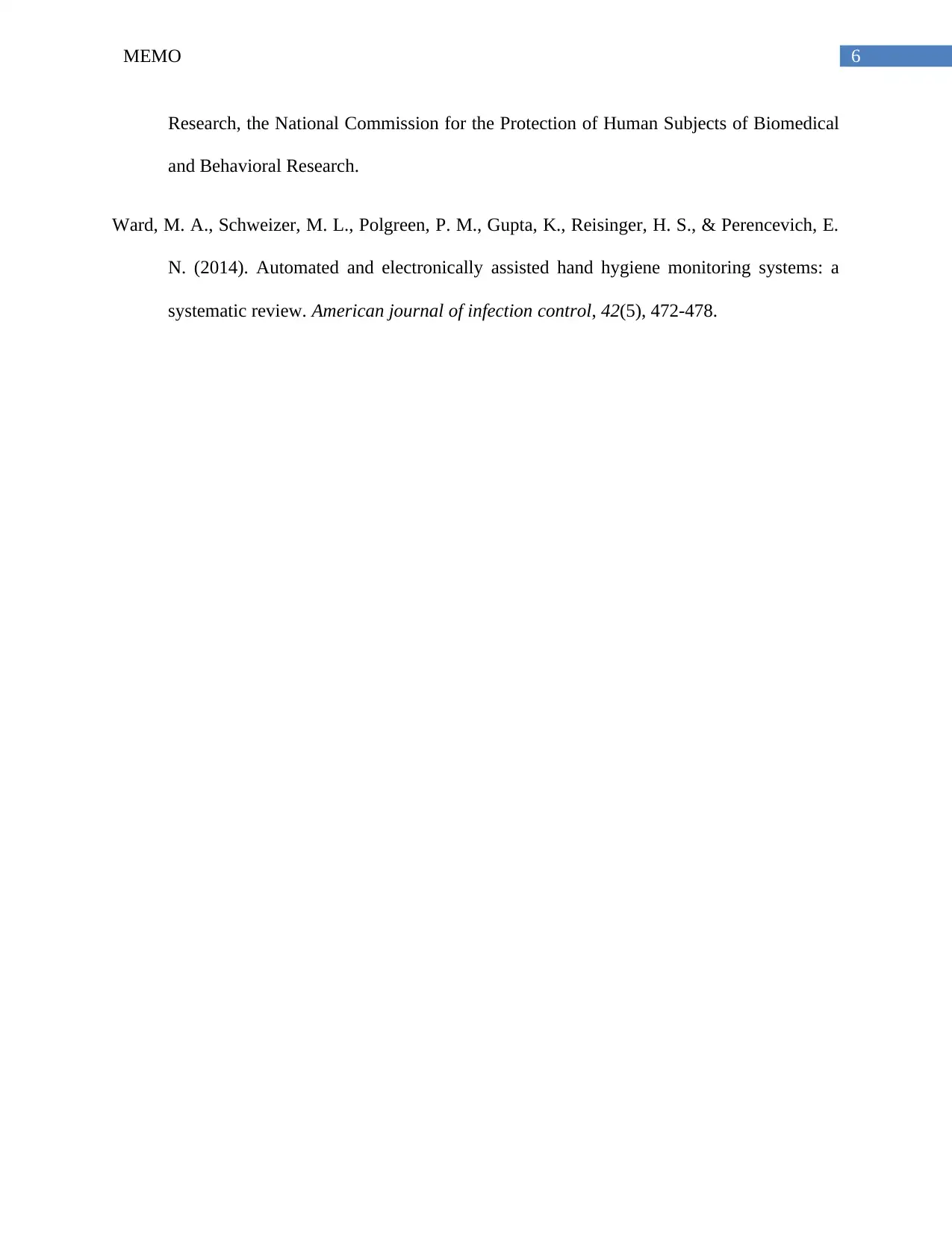
6MEMO
Research, the National Commission for the Protection of Human Subjects of Biomedical
and Behavioral Research.
Ward, M. A., Schweizer, M. L., Polgreen, P. M., Gupta, K., Reisinger, H. S., & Perencevich, E.
N. (2014). Automated and electronically assisted hand hygiene monitoring systems: a
systematic review. American journal of infection control, 42(5), 472-478.
Research, the National Commission for the Protection of Human Subjects of Biomedical
and Behavioral Research.
Ward, M. A., Schweizer, M. L., Polgreen, P. M., Gupta, K., Reisinger, H. S., & Perencevich, E.
N. (2014). Automated and electronically assisted hand hygiene monitoring systems: a
systematic review. American journal of infection control, 42(5), 472-478.
1 out of 7
Related Documents
Your All-in-One AI-Powered Toolkit for Academic Success.
+13062052269
info@desklib.com
Available 24*7 on WhatsApp / Email
![[object Object]](/_next/static/media/star-bottom.7253800d.svg)
Unlock your academic potential
Copyright © 2020–2025 A2Z Services. All Rights Reserved. Developed and managed by ZUCOL.





